第五届“学府杯”翻译竞赛原文(英译汉)
- 格式:doc
- 大小:30.50 KB
- 文档页数:2
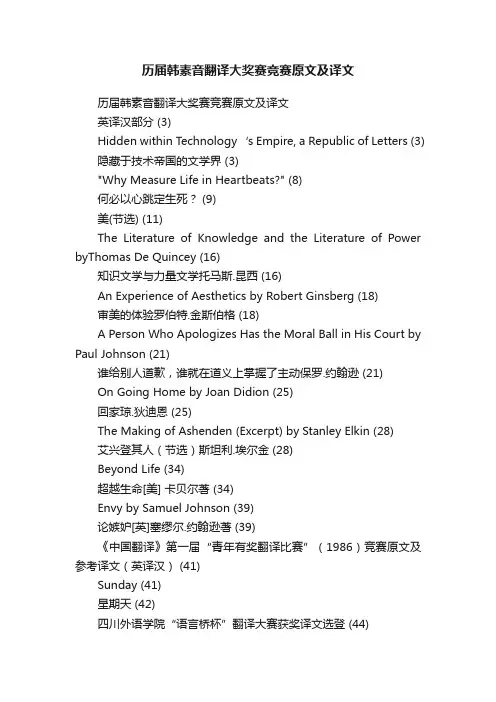
历届韩素音翻译大奖赛竞赛原文及译文历届韩素音翻译大奖赛竞赛原文及译文英译汉部分 (3)Hidden within Technology‘s Empire, a Republic of Letters (3)隐藏于技术帝国的文学界 (3)"Why Measure Life in Heartbeats?" (8)何必以心跳定生死? (9)美(节选) (11)The Literature of Knowledge and the Literature of Power byThomas De Quincey (16)知识文学与力量文学托马斯.昆西 (16)An Experience of Aesthetics by Robert Ginsberg (18)审美的体验罗伯特.金斯伯格 (18)A Person Who Apologizes Has the Moral Ball in His Court by Paul Johnson (21)谁给别人道歉,谁就在道义上掌握了主动保罗.约翰逊 (21)On Going Home by Joan Didion (25)回家琼.狄迪恩 (25)The Making of Ashenden (Excerpt) by Stanley Elkin (28)艾兴登其人(节选)斯坦利.埃尔金 (28)Beyond Life (34)超越生命[美] 卡贝尔著 (34)Envy by Samuel Johnson (39)论嫉妒[英]塞缪尔.约翰逊著 (39)《中国翻译》第一届“青年有奖翻译比赛”(1986)竞赛原文及参考译文(英译汉) (41)Sunday (41)星期天 (42)四川外语学院“语言桥杯”翻译大赛获奖译文选登 (44)第七届“语言桥杯”翻译大赛获奖译文选登 (44)The Woods: A Meditation (Excerpt) (46)林间心语(节选) (47)第六届“语言桥杯”翻译大赛获奖译文选登 (50)第五届“语言桥杯”翻译大赛原文及获奖译文选登 (52)第四届“语言桥杯”翻译大赛原文、参考译文及获奖译文选登 (54) When the Sun Stood Still (54)永恒夏日 (55)CASIO杯翻译竞赛原文及参考译文 (56)第三届竞赛原文及参考译文 (56)Here Is New York (excerpt) (56)这儿是纽约 (58)第四届翻译竞赛原文及参考译文 (61)Reservoir Frogs (Or Places Called Mama's) (61)水库青蛙(又题:妈妈餐馆) (62)中译英部分 (66)蜗居在巷陌的寻常幸福 (66)Simple Happiness of Dwelling in the Back Streets (66)在义与利之外 (69)Beyond Righteousness and Interests (69)读书苦乐杨绛 (72)The Bitter-Sweetness of Reading Yang Jiang (72)想起清华种种王佐良 (74)Reminiscences of Tsinghua Wang Zuoliang (74)歌德之人生启示宗白华 (76)What Goethe's Life Reveals by Zong Baihua (76)怀想那片青草地赵红波 (79)Yearning for That Piece of Green Meadow by Zhao Hongbo (79)可爱的南京 (82)Nanjing the Beloved City (82)霞冰心 (84)The Rosy Cloud byBingxin (84)黎明前的北平 (85)Predawn Peiping (85)老来乐金克木 (86)Delights in Growing Old by Jin Kemu (86)可贵的“他人意识” (89)Calling for an Awareness of Others (89)教孩子相信 (92)To Implant In Our Children‘s Young Hearts An Undying Faith In Humanity (92)心中有爱 (94)Love in Heart (94)英译汉部分Hidden within Technology’s Empire, a Republic of Le tters 隐藏于技术帝国的文学界索尔·贝娄(1)When I was a boy ―discovering literature‖, I used to think how wonderful it would be if every other person on the street were familiar with Proust and Joyce or T. E. Lawrence or Pasternak and Kafka. Later I learned how refractory to high culture the democratic masses were. Lincoln as a young frontiersman read Plutarch, Shakespeare and the Bible. But then he was Lincoln.我还是个“探索文学”的少年时,就经常在想:要是大街上人人都熟悉普鲁斯特和乔伊斯,熟悉T.E.劳伦斯,熟悉帕斯捷尔纳克和卡夫卡,该有多好啊!后来才知道,平民百姓对高雅文化有多排斥。
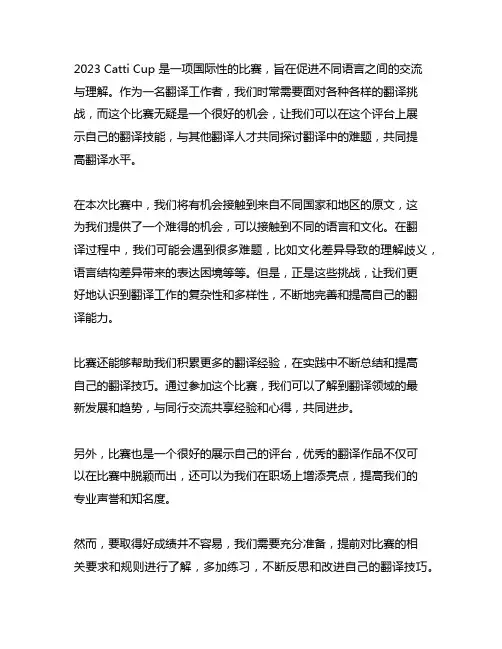
2023 Catti Cup 是一项国际性的比赛,旨在促进不同语言之间的交流与理解。
作为一名翻译工作者,我们时常需要面对各种各样的翻译挑战,而这个比赛无疑是一个很好的机会,让我们可以在这个评台上展示自己的翻译技能,与其他翻译人才共同探讨翻译中的难题,共同提高翻译水平。
在本次比赛中,我们将有机会接触到来自不同国家和地区的原文,这为我们提供了一个难得的机会,可以接触到不同的语言和文化。
在翻译过程中,我们可能会遇到很多难题,比如文化差异导致的理解歧义,语言结构差异带来的表达困境等等。
但是,正是这些挑战,让我们更好地认识到翻译工作的复杂性和多样性,不断地完善和提高自己的翻译能力。
比赛还能够帮助我们积累更多的翻译经验,在实践中不断总结和提高自己的翻译技巧。
通过参加这个比赛,我们可以了解到翻译领域的最新发展和趋势,与同行交流共享经验和心得,共同进步。
另外,比赛也是一个很好的展示自己的评台,优秀的翻译作品不仅可以在比赛中脱颖而出,还可以为我们在职场上增添亮点,提高我们的专业声誉和知名度。
然而,要取得好成绩并不容易,我们需要充分准备,提前对比赛的相关要求和规则进行了解,多加练习,不断反思和改进自己的翻译技巧。
也要不断学习和积累相关的专业知识和词汇量,提高自己的语言能力和翻译水平。
参加 2023 Catti Cup 是一次难得的机会,无论是对于我们个人的职业发展,还是对于整个翻译行业的发展来说,都具有重要意义。
让我们抓住这个机会,充分发挥我们的优势,不断提高我们的翻译水平,为推动翻译行业的发展做出自己的贡献。
很多人可能会问,为什么要参加翻译比赛?参加翻译比赛能够带来哪些好处?参加翻译比赛可以提高我们的翻译技能和水平。
参加比赛需要我们面对各种各样的挑战和困难,在这个过程中,我们会不断学习,积累经验,得到成长。
比赛的压力会促使我们更加努力地学习和练习,以期在比赛中取得好成绩。
并且在比赛中,我们有机会接触到各种领域、各种类型的文本,这些都可以为我们的翻译积累宝贵的经验,提高我们的翻译水平。
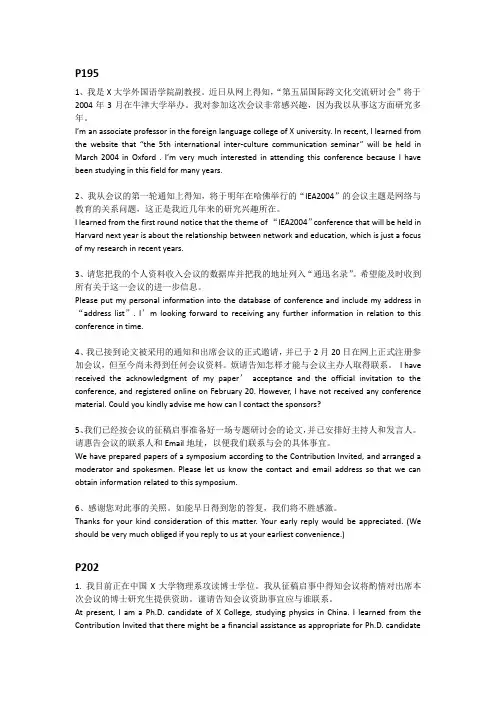
P1951、我是X大学外国语学院副教授。
近日从网上得知,“第五届国际跨文化交流研讨会”将于2004年3月在牛津大学举办。
我对参加这次会议非常感兴趣,因为我以从事这方面研究多年。
I’m an associate professor in the foreign language college of X university. In recent, I learned from the website that “the 5th international inter-culture communication seminar” will be held in March 2004 in Oxford . I’m very much interested in attending this conference because I have been studying in this field for many years.2、我从会议的第一轮通知上得知,将于明年在哈佛举行的“IEA2004”的会议主题是网络与教育的关系问题,这正是我近几年来的研究兴趣所在。
I learned from the first round notice that the theme of “IEA2004”conference that will be held in Harvard next year is about the relationship between network and education, which is just a focus of my research in recent years.3、请您把我的个人资料收入会议的数据库并把我的地址列入“通迅名录”。
希望能及时收到所有关于这一会议的进一步信息。
Please put my personal information into the database of conference and include my address in “address list”. I’m looking forward to receiving any further information in relation to this conference in time.4、我已接到论文被采用的通知和出席会议的正式邀请,并已于2月20日在网上正式注册参加会议,但至今尚未得到任何会议资料。
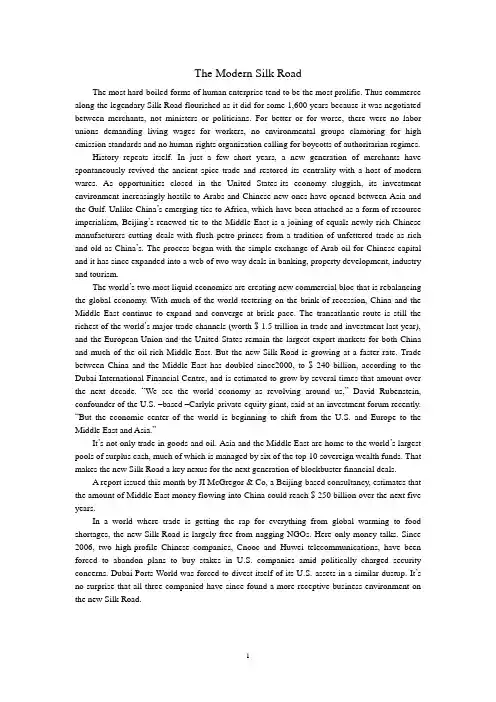
The Modern Silk RoadThe most hard-boiled forms of human enterprise tend to be the most prolific. Thus commerce along the legendary Silk Road flourished as it did for some 1,600 years because it was negotiated between merchants, not ministers or politicians. For better or for worse, there were no labor unions demanding living wages for workers, no environmental groups clamoring for high emission standards and no human-rights organization calling for boycotts of authoritarian regimes.History repeats itself. In just a few short years, a new generation of merchants have spontaneously revived the ancient spice trade and restored its centrality with a host of modern wares. As opportunities closed in the United States-its economy sluggish, its investment environment increasingly hostile to Arabs and Chinese-new ones have opened between Asia and the Gulf. Unlike China’s emerging ties to Africa, which have been attached as a form of resource imperialism, Beijing’s renewed tie to the Middle East is a joining of equals-newly rich Chinese manufacturers cutting deals with flush petro-princes from a tradition of unfettered trade as rich and old as China’s. The process began with the simple exchange of Arab oil for Chinese capital and it has since expanded into a web of two-way deals in banking, property development, industry and tourism.The world’s two most liquid economies are creating new commercial bloc that is rebalancing the global economy. With much of the world teetering on the brink of recession, China and the Middle East continue to expand and converge at brisk pace. The transatlantic route is still the richest of the world’s major trade channels (worth $ 1.5 trillion in trade and investment last year), and the European Union and the United States remain the largest export markets for both China and much of the oil-rich Middle East. But the new Silk Road is growing at a faster rate. Trade between China and the Middle East has doubled since2000, to $ 240 billion, according to the Dubai International Financial Centre, and is estimated to grow by several times that amount over the next decade. “We see the world economy as revolving around us,”David Rubenstein, confounder of the U.S. –based –Carlyle private-equity giant, said at an investment forum recently. “But the economic center of the world is beginning to shift from the U.S. and Europe to the Middle East and Asia.”It’s not only trade in goods and oil. Asia and the Middle East are home to the world’s largest pools of surplus cash, much of which is managed by six of the top 10 sovereign wealth funds. That makes the new Silk Road a key nexus for the next generation of blockbuster financial deals.A report issued this month by JI McGregor & Co, a Beijing-based consultancy, estimates that the amount of Middle East money flowing into China could reach $ 250 billion over the next five years.In a world where trade is getting the rap for everything from global warming to food shortages, the new Silk Road is largely free from nagging NGOs. Here only money talks. Since 2006, two high-profile Chinese companies, Cnooc and Huwei telecommunications, have been forced to abandon plans to buy stakes in U.S. companies amid politically charged security concerns. Dubai Ports World was forced to divest itself of its U.S. assets in a similar dustup. It’s no surprise that all three companied have since found a more receptive business environment on the new Silk Road.1。
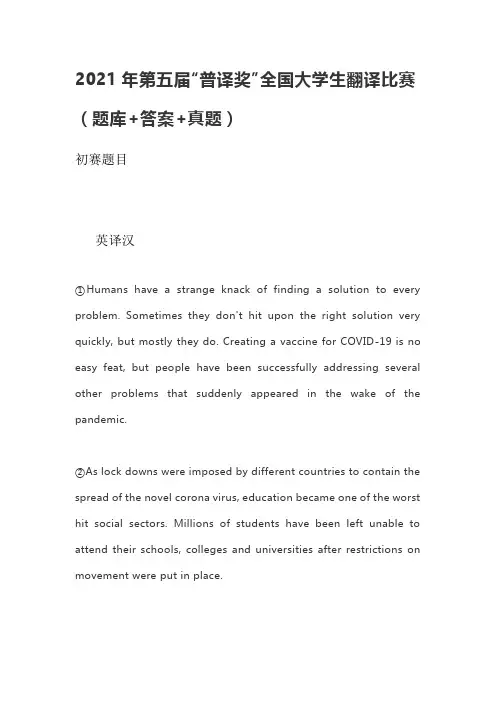
2021年第五届“普译奖”全国大学生翻译比赛(题库+答案+真题)初赛题目英译汉①Humans have a strange knack of finding a solution to every problem. Sometimes they don't hit upon the right solution very quickly, but mostly they do. Creating a vaccine for COVID-19 is no easy feat, but people have been successfully addressing several other problems that suddenly appeared in the wake of the pandemic.②As lock downs were imposed by different countries to contain the spread of the novel corona virus, education became one of the worst hit social sectors. Millions of students have been left unable to attend their schools, colleges and universities after restrictions on movement were put in place.③COVID-19 may turn out to be a game-changer for the education sector, and especially for poorer nations with limited resources and an inability to construct traditional infrastructure for education. They can now embark on mass-level education programs by using free online resources.④However, there are also certain challenges to this rise in virtual education, the most important of which is affordability. Other key questions include addressing how many people can buy gadgets and access online resources. The issue of poverty is therefore a big hurdle for millions of people across the globe in accessing online education.⑤Another challenge is a lack of well-trained personnel. In less developed countries, teachers may not be tech-savvy enough to exploit the latest online materials and so they should be first trained in order to leverage this opportunity.⑥Governments and education authorities may also face problems as they are accustomed to the traditional system and convincing them to move to online platforms will be a daunting task.⑦The current trend of online teaching is a good start in addressing some of the most pressing problems for students in the short term, but fully utilizing it in the long term will require more coordinated and focused efforts.汉译英2020年春天,新冠肺炎疫情改写了世界历史。
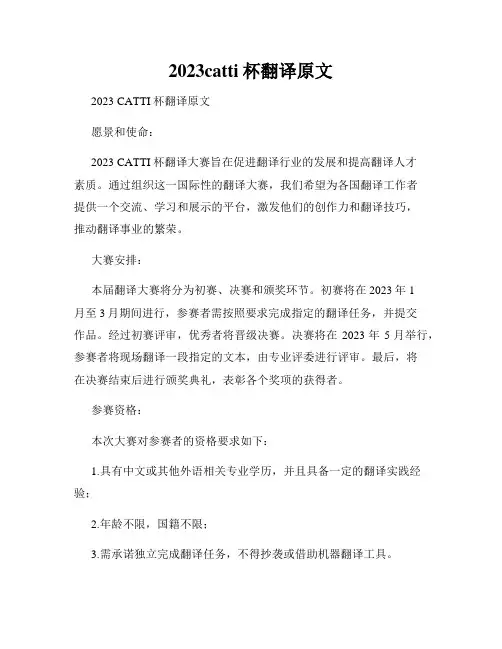
2023catti杯翻译原文2023 CATTI杯翻译原文愿景和使命:2023 CATTI杯翻译大赛旨在促进翻译行业的发展和提高翻译人才素质。
通过组织这一国际性的翻译大赛,我们希望为各国翻译工作者提供一个交流、学习和展示的平台,激发他们的创作力和翻译技巧,推动翻译事业的繁荣。
大赛安排:本届翻译大赛将分为初赛、决赛和颁奖环节。
初赛将在2023年1月至3月期间进行,参赛者需按照要求完成指定的翻译任务,并提交作品。
经过初赛评审,优秀者将晋级决赛。
决赛将在2023年5月举行,参赛者将现场翻译一段指定的文本,由专业评委进行评审。
最后,将在决赛结束后进行颁奖典礼,表彰各个奖项的获得者。
参赛资格:本次大赛对参赛者的资格要求如下:1.具有中文或其他外语相关专业学历,并且具备一定的翻译实践经验;2.年龄不限,国籍不限;3.需承诺独立完成翻译任务,不得抄袭或借助机器翻译工具。
翻译任务:本次大赛的翻译任务主要包括文学、科技、经济、法律和时事等领域。
详细的翻译要求将在初赛开始前公布,并根据不同的语种设置相应的任务。
评委团队:本届大赛将邀请一流的翻译学者和专业人士组成评委团队,他们将负责对参赛者的作品进行评审和打分。
评委团队将严格按照统一的评分标准进行评判,确保公正、客观地选出最优秀的翻译作品。
奖项设置:本次大赛将设置一、二、三等奖以及优秀奖、人气奖等附加奖项。
每个奖项将评选出数量不等的获奖者,以表彰他们在翻译任务中的出色表现。
此外,大赛还将邀请优秀的获奖者参加一系列研讨会和培训活动,提高他们的专业能力。
宣传推广:为了让更多的翻译工作者了解和参与本届大赛,我们将通过各种渠道进行宣传推广,包括但不限于媒体报道、社交媒体推广、翻译机构合作等。
我们相信,通过广泛的宣传,能够吸引更多优秀的翻译从业者积极参与,使本次大赛更加具有影响力和参与度。
总结:2023 CATTI杯翻译大赛是一项重要的国际翻译赛事,旨在提高翻译人才素质,促进翻译事业的发展。
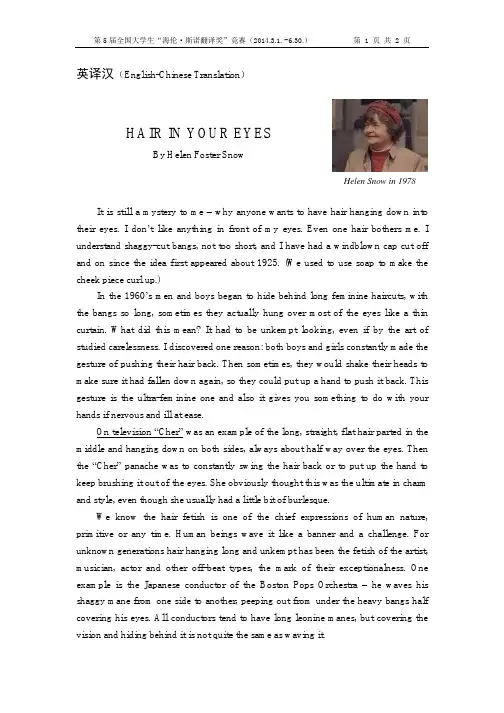
英译汉(English-Chinese Translation)HAIR IN YOUR EYESBy Helen Foster SnowHelen Snow in 1978It is still a mystery to me – why anyone wants to have hair hanging down into their eyes. I don’t like anything in front of my eyes. Even one hair bothers me. I understand shaggy-cut bangs, not too short, and I have had a windblown cap cut off and on since the idea first appeared about 1925. (We used to use soap to make the cheek piece curl up.)In the 1960’s men and boys began to hide behind long feminine haircuts, with the bangs so long, sometimes they actually hung over most of the eyes like a thin curtain. What did this mean? It had to be unkempt looking, even if by the art of studied carelessness. I discovered one reason: both boys and girls constantly made the gesture of pushing their hair back. Then sometimes, they would shake their heads to make sure it had fallen down again, so they could put up a hand to push it back. This gesture is the ultra-feminine one and also it gives you something to do with your hands if nervous and ill at ease.On television “Cher” was an example of the long, straight, flat hair parted in the middle and hanging down on both sides, always about half way over the eyes. Then the “Cher” panache was to constantly swing the hair back or to put up the hand to keep brushing it out of the eyes. She obviously thought this was the ultimate in charm and style, even though she usually had a little bit of burlesque.We know the hair fetish is one of the chief expressions of human nature, primitive or any time. Human beings wave it like a banner and a challenge. For unknown generations hair hanging long and unkempt has been the fetish of the artist, musician, actor and other off-beat types, the mark of their exceptionalness. One example is the Japanese conductor of the Boston Pops Orchestra –he waves his shaggy mane from one side to another, peeping out from under the heavy bangs half covering his eyes. All conductors tend to have long leonine manes, but covering the vision and hiding behind it is not quite the same as waving it.I once had a severe nosebleed and went to the emergency ward of Yale New Haven Hospital. I was assigned to a young Japanese woman, training to be a doctor. Her hair was short and so heavy and bushy, she actually could not see through the overlong heavy bangs and had to keep brushing them out of her eyes right in the middle of using a scalpel and mirror to cut off the artery. In the end, she made such a “hairy” mess of it, she had to call another doctor to do the job – he was a real square, fortunately, with nice neat short hair and good glasses.When I was in China in 1970’s, I was always bothered by the straight wisps of hair escaping from a bobby pin to hold the bangs back and directly obscuring the vision. I could not understand it at all, but assumed the hair grew in that intractable manner. I well remembered in the 1930’s when the old-fashioned women plucked their foreheads to make a square, then brushed the long hair down like a crow’s wing to be as flat as possible.When I was a child, my grandmother’s second husband was the superintendent of a big insane asylum. Once or twice I went there and I noticed that unkempt hair was the common denominator, also that the wildest inmates hid behind heavy locks in front and peered out with paranoid fear and hostility. In fact, I am writing this today because last night I watched “Nicholas Nickleby”on television. The retarded boy, Smike, had been hiding behind long unkempt hair over his eyes – a miracle occurred when it was cut short all over.In the 1960’s one of my aged friends went to visit a family of relatives around Halloween. Their girls appeared in long calico skirts with the long straight hair hanging like witches and covering half their eyes. At first she thought it was a costume party for the holiday –but of course, that was the ne plus ultra of young fashion then all the time.A few minutes ago I watched a woman author on the Donahue show. Her long bangs were curved, but resting actually on the eyelids. She thought herself most attractive, but this hair problem gave me the “creeps”.(Madison, 14 January 1983)。
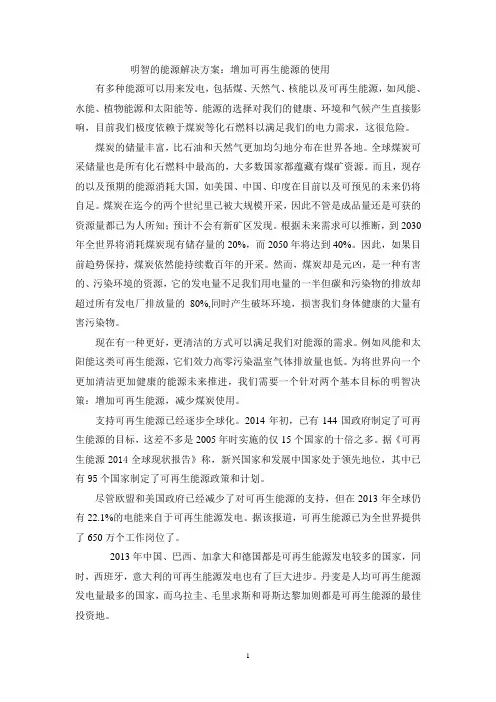
明智的能源解决方案:增加可再生能源的使用有多种能源可以用来发电,包括煤、天然气、核能以及可再生能源,如风能、水能、植物能源和太阳能等。
能源的选择对我们的健康、环境和气候产生直接影响,目前我们极度依赖于煤炭等化石燃料以满足我们的电力需求,这很危险。
煤炭的储量丰富,比石油和天然气更加均匀地分布在世界各地。
全球煤炭可采储量也是所有化石燃料中最高的,大多数国家都蕴藏有煤矿资源。
而且,现存的以及预期的能源消耗大国,如美国、中国、印度在目前以及可预见的未来仍将自足。
煤炭在迄今的两个世纪里已被大规模开采,因此不管是成品量还是可获的资源量都已为人所知;预计不会有新矿区发现。
根据未来需求可以推断,到2030年全世界将消耗煤炭现有储存量的20%,而2050年将达到40%。
因此,如果目前趋势保持,煤炭依然能持续数百年的开采。
然而,煤炭却是元凶,是一种有害的、污染环境的资源,它的发电量不足我们用电量的一半但碳和污染物的排放却超过所有发电厂排放量的80%,同时产生破坏环境,损害我们身体健康的大量有害污染物。
现在有一种更好,更清洁的方式可以满足我们对能源的需求。
例如风能和太阳能这类可再生能源,它们效力高零污染温室气体排放量也低。
为将世界向一个更加清洁更加健康的能源未来推进,我们需要一个针对两个基本目标的明智决策:增加可再生能源,减少煤炭使用。
支持可再生能源已经逐步全球化。
2014年初,已有144国政府制定了可再生能源的目标,这差不多是2005年时实施的仅15个国家的十倍之多。
据《可再生能源2014全球现状报告》称,新兴国家和发展中国家处于领先地位,其中已有95个国家制定了可再生能源政策和计划。
尽管欧盟和美国政府已经减少了对可再生能源的支持,但在2013年全球仍有22.1%的电能来自于可再生能源发电。
据该报道,可再生能源已为全世界提供了650万个工作岗位了。
2013年中国、巴西、加拿大和德国都是可再生能源发电较多的国家,同时,西班牙,意大利的可再生能源发电也有了巨大进步。
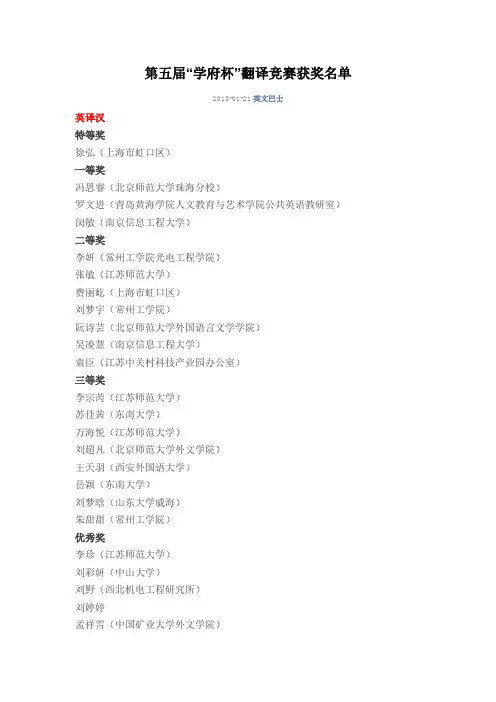
第五届“学府杯”翻译竞赛获奖名单2015-01-21英文巴士英译汉特等奖徐弘(上海市虹口区)一等奖冯思睿(北京师范大学珠海分校)罗文进(青岛黄海学院人文教育与艺术学院公共英语教研室)闵敏(南京信息工程大学)二等奖李妍(常州工学院光电工程学院)张敏(江苏师范大学)费丽屹(上海市虹口区)刘梦宇(常州工学院)阮诗芸(北京师范大学外国语言文学学院)吴凌慧(南京信息工程大学)袁臣(江苏中关村科技产业园办公室)三等奖李宗芮(江苏师范大学)苏佳茜(东南大学)万海悦(江苏师范大学)刘超凡(北京师范大学外文学院)王天羽(西安外国语大学)岳颖(东南大学)刘梦晗(山东大学威海)朱甜甜(常州工学院)优秀奖李珍(江苏师范大学)刘彩妍(中山大学)刘野(西北机电工程研究所)刘婷婷孟祥雪(中国矿业大学外文学院)汪顺来(常州工学院外国语学院)李诗意(对外经济贸易大学)吴颖(中国石油勘探开发研究院)张群群(中国社会科学院财经战略研究院)张茹(漯河高中高三文6班)佟浩(北京大学)赵东亮(解放军理工大学军教院三旅五连)汉译英特等奖李小撒(南京信息工程大学)一等奖胡波(南京理工大学泰州科技学院)李楠(东南大学外国语学院)崔秀忠二等奖宝静雅(内蒙古呼和浩特市)刘超凡(北京师范大学外文学院)冀琳(南京信息工程大学)顾婧吴枫北(中南大学)赵方祎(上海政法学院外国语学院)董振邦三等奖梁丽红(扬州工业职业技术学院)张群群(中国社会科学院财经战略研究院)徐兆星(黄山学院)张蕾(扬州大学)闵敏(南京信息工程大学)郑莉丽(南京信息工程大学)占文英(中国矿业大学)邓芳(江南大学外国语学院)孙君倩(南京林业大学)王蓉(中国海洋大学)优秀奖姚子骏刘晓静(三江学院英语系)姚中芹(南京信息工程大学)陈雨婷(南京信息工程大学)张志(东南大学)李汉明(西南科技大学外国语学院)纪玥刘伊杨(东南大学)。
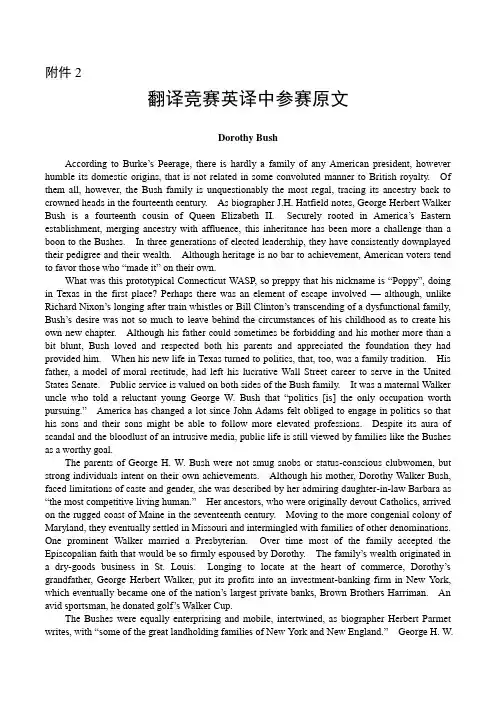
附件2翻译竞赛英译中参赛原文Dorothy BushAccording to Burke’s Peerage, there is hardly a family of any American president, however humble its domestic origins, that is not related in some convoluted manner to British royalty. Of them all, however, the Bush family is unquestionably the most regal, tracing its ancestry back to crowned heads in the fourteenth century. As biographer J.H. Hatfield notes, George Herbert Walker Bush is a fourteenth cousin of Queen Elizabeth II. Securely rooted in America’s Eastern establishment, merging ancestry with affluence, this inheritance has been more a challenge than a boon to the Bushes. In three generations of elected leadership, they have consistently downplayed their pedigree and their wealth. Although heritage is no bar to achievement, American voters tend to favor those who “made it” on their own.What was this prototypical Connecticut WASP, so preppy that his nickname is “Poppy”, doing in Texas in the first place? Perhaps there was an element of escape involved —although, unlike Richard Nixon’s longing after train whistles or Bill Clinton’s transcending of a dysfunctional family, Bush’s desire was not so much to leave behind the circumstances of his childhood as to create his own new chapter. Although his father could sometimes be forbidding and his mother more than a bit blunt, Bush loved and respected both his parents and appreciated the foundation they had provided him. When his new life in Texas turned to politics, that, too, was a family tradition. His father, a model of moral rectitude, had left his lucrative Wall Street career to serve in the United States Senate. Public service is valued on both sides of the Bush family. It was a maternal Walker uncle who told a reluctant young George W. Bush that “politics [is] the only occupation worth pursuing.” America has changed a lot since John Adams felt obliged to engage in politics so that his sons and their sons might be able to follow more elevated professions. Despite its aura of scandal and the bloodlust of an intrusive media, public life is still viewed by families like the Bushes as a worthy goal.The parents of George H. W. Bush were not smug snobs or status-conscious clubwomen, but strong individuals intent on their own achievements. Although his mother, Dorothy Walker Bush, faced limitations of caste and gender, she was described by her admiring daughter-in-law Barbara as “the most competitive living human.” Her ancestors, who were originally devout Catholics, arrived on the rugged coast of Maine in the seventeenth century. Moving to the more congenial colony of Maryland, they eventually settled in Missouri and intermingled with families of other denominations. One prominent Walker married a Presbyterian. Over time most of the family accepted the Episcopal ian faith that would be so firmly espoused by Dorothy. The family’s wealth originated in a dry-goods business in St. Louis. Longing to locate at the heart of commerce, Dorothy’s grandfather, George Herbert Walker, put its profits into an investment-banking firm in New York, which eventually became one of the nation’s largest private banks, Brown Brothers Harriman. An avid sportsman, he donated golf’s Walker Cup.The Bushes were equally enterprising and mobile, intertwined, as biographer Herbert Parmet wr ites, with “some of the great landholding families of New York and New England.” George H. W.Bush’s genial grandfather, Samuel, made his fortune not in Manhattan but as an industrialist in Columbus, Ohio. His son Prescott Bush, born in 1895, was sent east to school, to Phillips Academy in Andover, Massachusetts, and later to Yale, initiating a family tradition. Settling first in Milton, Massachusetts, Prescott made his own fortune as a Wall Street banker. The words used most often to characterize him a re “imposing,” “stern,” and “commanding.” He grew to six feet, four inches, with a full head of black hair. Parmet describes him as “austere, regal, dignified, and imperious” —a classic authority figure. He loved children, however, and would have five, although most of the day-to-day childrearing was always in the hands of his wife, Dorothy, whom he would marry in 1921 at the Church of Saint Ann in Kennebunkport, Maine.Had she been born a generation or two later, Dorothy Walker might have had a dazzling career of her own. She was the fire to her husband’s ice —outgoing, amusing, outspoken, and adventuresome, yet very much a lady. A proper marriage for her was the preoccupation of Dorothy’s protective parents, who still lived in St. Louis. After atte nding private schools, she was sent east for “finishing” at Miss Porter’s School in Farmington, Connecticut, in preparation for her presentation to society. Called “Dottie,” she particularly excelled in athletics. In 1918 she was runner-up in the girls’ national tennis tournament. She was so gifted an athlete that even at the age of thirty-nine, a mother of five, she took a set from a lady who had lost in the national tennis finals to the legendary Alice Marble.They were a handsome couple, Dorothy and Prescott Bush, although she was the more cheerful and sociable. Their first son, named for his father, was born after the frantic hospital ride in 1922. Two years later, their second son was horn, and named George Herbert Walker Bush, representing both f amilies. His grandfather Walker called him “Little Pop,” which became “Poppy.” There would be two more boys, and a welcome girl, Nancy. As Prescott’s investment house prospered, merged, and moved to Manhattan, the family relocated to a larger, comfortably unostentatious home in Greenwich, Connecticut.选自:Faith of Our Mothers 作者:Harold Gullan。
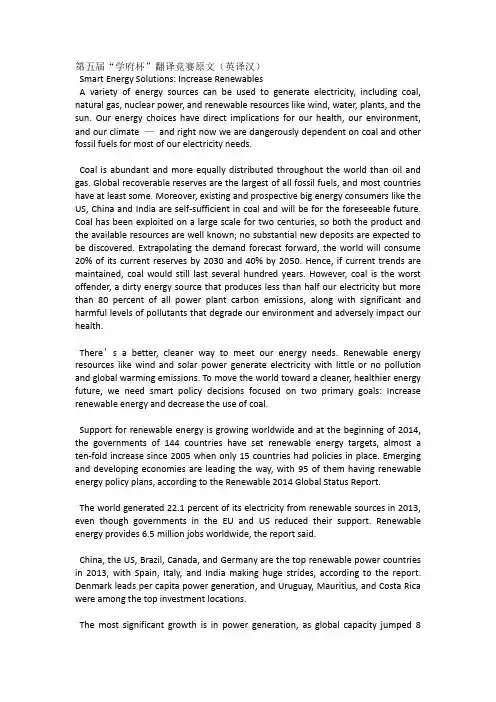
第五届“学府杯”翻译竞赛原文(英译汉)Smart Energy Solutions: Increase RenewablesA variety of energy sources can be used to generate electricity, including coal, natural gas, nuclear power, and renewable resources like wind, water, plants, and the sun. Our energy choices have direct implications for our health, our environment, and our climate —and right now we are dangerously dependent on coal and other fossil fuels for most of our electricity needs.Coal is abundant and more equally distributed throughout the world than oil and gas. Global recoverable reserves are the largest of all fossil fuels, and most countries have at least some. Moreover, existing and prospective big energy consumers like the US, China and India are self-sufficient in coal and will be for the foreseeable future. Coal has been exploited on a large scale for two centuries, so both the product and the available resources are well known; no substantial new deposits are expected to be discovered. Extrapolating the demand forecast forward, the world will consume 20% of its current reserves by 2030 and 40% by 2050. Hence, if current trends are maintained, coal would still last several hundred years. However, coal is the worst offender, a dirty energy source that produces less than half our electricity but more than 80 percent of all power plant carbon emissions, along with significant and harmful levels of pollutants that degrade our environment and adversely impact our health.There’s a better, cleaner way to meet our energy needs. Renewable energy resources like wind and solar power generate electricity with little or no pollution and global warming emissions. To move the world toward a cleaner, healthier energy future, we need smart policy decisions focused on two primary goals: Increase renewable energy and decrease the use of coal.Support for renewable energy is growing worldwide and at the beginning of 2014, the governments of 144 countries have set renewable energy targets, almost a ten-fold increase since 2005 when only 15 countries had policies in place. Emerging and developing economies are leading the way, with 95 of them having renewable energy policy plans, according to the Renewable 2014 Global Status Report.The world generated 22.1 percent of its electricity from renewable sources in 2013, even though governments in the EU and US reduced their support. Renewable energy provides 6.5 million jobs worldwide, the report said.China, the US, Brazil, Canada, and Germany are the top renewable power countries in 2013, with Spain, Italy, and India making huge strides, according to the report. Denmark leads per capita power generation, and Uruguay, Mauritius, and Costa Rica were among the top investment locations.The most significant growth is in power generation, as global capacity jumped 8percent to more than 1,560 gigawatts (GW) in the last year. Hydropower rose by 4 percent to 1,000 GW, and overall renewables grew 17 percent to more than 560 GW.Over 140 countries have adopted new renewable energy targets, including the United States, which has pledged to increase renewable energy capacity 50 percent by 2020. President Obama has promised to slash America’s dependence on coal, and to switch power plants towards cleaner energy.However, it will be difficult for America to switch off coal consumption, as many states depend on it for their economic livelihood. Many lobbying groups are protesting the new clean energy act, saying it unfairly deprives local industries. Even though coal is a proven dirty energy source consumption has reached a 44-year high. Alternative and clean energy is no longer just a hip trend among environmentalists, but a real energy solution that provides power to homes and offices. The market has matured and become an attractive option for energy security. From the currently available technologies, solar photovoltaics, followed by wind power, concentrated solar power and geothermal, have the highest potentials in the power sector. The use of ocean energy might be significantly higher, but with the current state of development, the technical and economical potential remains unclear.Germany is pushing its economy towards renewables, and produces half of its electricity from solar power, The Local reports. In Denmark wind power meets 33 percent of electricity demand, in Spain 20.9 percent, and in Italy solar power meets 7.8 percent of electricity needs. Many cities across the globe have a goal to transition to 100% renewable energy.Over the last 5 years, solar power has on average expanded 55 percent per year, according to the report. Clean energy is becoming cheaper and more popular with consumers, and investors are snapping up the opportunity. Elon Musk, the entrepreneur who invested early in PayPal and the Tesla electric car, has put money into solar power, and Google is weighing a move into the renewables sector.Current levels of renewables development represent only a tiny fraction of what could be developed. Many regions of the world are rich in renewable resources. Spain and Portugal sit on a bed of geothermal energy, but currently use none of it. Scientists from the Renewable Energy Journal estimate Spain has the potential to produce up to 700 GW, which is five times the current electricity power generation of Spain.第五届“学府杯”翻译竞赛原文(汉译英)“圈子”没那么重要“刚才明明还在说笑,怎么我一走过来就闭嘴了,难道是在说我什么吗?”“看着同事们谈笑风生,我也想融入进去,可就是插不上嘴……”刚从学校踏入社会的职场年轻人,面对陌生的职场环境,往往会出现一段时期的“社交空窗”,总感觉自己被排除在圈子之外,融入不了主流群体之中,这也是年轻人最容易感到苦闷的事情。
Limbo等待By Rhonda Lucas朗达‧卢卡斯My parents’ divorce was final. The house had been sold and the day had come to move. Thirty years of the family’s life was now crammed into the garage. The two-by-fours that ran the length of the walls were the only uniformity among the clutter of boxes, furniture, and memories. All was frozen in limbo between the life just passed and the one to come. 父母最终还是离了婚,房子卖了出去,搬家的日子到了。
一个家30年生活的种种现在被塞进了车库。
车库里堆满了各色盒子、家具和回忆,杂乱不堪,从一端延伸到另一端的2英寸厚4英寸宽的木板是唯一整齐有序的。
一切的一切似乎都在焦急地等待着告别过去,迎接未来。
The sunlight pushing its way through the window splattered against a barricade of boxes. Like a fluorescent river, it streamed down the sides and flooded the cracks of the cold, cement floor. I stood in the doorway between the house and garage and wondered if the sunlight would ever again penetrate the memories packed inside those boxes. For an instant, the cardboard boxes appeared as tombstones, monuments to those memories.阳光奋力透过窗户,洒在堆成墙的硬纸板盒子上,像一条荧光河,顺着墙边流,流进冰冷水泥地上的裂缝里。
第五届“《英语世界》杯”翻译大赛比赛原文LimboBy Rhonda LucasM y parents’ divorce was final. The house had been sold and the day had come to move. Thirty years of the family’s life was now crammed into the garage. The two-by-fours that ran the length of the walls were the only uniformity among the clutter of boxes, furniture, and memories. All was frozen in limbo between the life just passed and the one to come.The sunlight pushing its way through the window splattered against a barricade of boxes. Like a fluorescent river, it streamed down the sides and flooded the cracks of the cold, cement floor.I stood in the doorway between the house and garage and wondered if the sunlight would ever again penetrate the memories packed inside those boxes. For an instant, the cardboard boxes appeared as tombstones, monuments to those memories.The furnace in the corner, with its huge tubular fingers reaching out and disappearing into the wall, was unaware of the futility of trying to warm the empty house. The rhythmical whir of its effort hummed the elegy for the memories boxed in front of me. I closed the door, sat down on the step, and listened reverently. The feeling of loss transformed the bad memories into not-so-bad, the not-so-bad memories into good, and committed the good ones to my mind. Still, I felt as vacant as the house inside.A workbench to my right stood disgustingly empty. Not so much as a nail had been left behind. I noticed, for the first time, what a dull, lifeless green it was. Lacking the disarray of tools thatused to cover it, now it seemed as out of place as a bathtub in the kitchen. In fact, as I scanned the room, the only things that did seem to belong were the cobwebs in the corners.A group of boxes had been set aside from the others and stacked in front of the workbench. Scrawled like graffiti on the wa lls of dilapidated buildings were the words “Salvation Army.” Those words caught my eyes as effectively as a flashing neon sign. They reeked of irony. “Salvation - was a bit too late for this family,” I mumbled sarcastically to mysel f.The houseful of furniture that had once been so carefully chosen to complement and blend with the color schemes of the various rooms was indiscriminately crammed together against a single wall. The uncoordinated colors combined in turmoil and lashed out in the greyness of the room.I suddenly became aware of the coldness of the garage, but I didn’t want to go back inside the house, so I made my way through the boxes to the couch. I cleared a space to lie down and curled up, covering myself with my jacket. I hoped my father would return soon with the truck so we could empty the garage and leave the cryptic silence of parting lives behind.(选自Patterns: A Short Prose Reader, by Mary Lou Conlin, published by Houghton Mifflin, 1983.)。
第二十四届“韩素音青年翻译奖”竞赛原文(英译汉)中国译协《中国翻译》编辑部与江苏人文环境艺术设计研究院联合举办第二十四届“韩素音青年翻译奖”竞赛,如下系英译汉的竞赛原文:It‟s Time to Rethink …Temporary‟We tend to view architecture as permanent, as aspiring to the status of monum ents. And that kind of architecture has its place. But so does architecture of a different sort.For most of the first decade of the 2000s, architecture was about the statement building. Whether it was a controversial memorial or an impossibly luxurious condo tower, architecture‟s raison d‟être was to make a las ting impression. Arc hitecture has always been synonymous with permanence, but should it be?In the last few years, the opposite may be true. Architectural billings are at an all-time low. Major commissions are few and far between. The architecture th at‟s b een making news is fast and fleeting: pop-up shops, food carts, marketpla ces, performance spaces. And while many manifestations of the genre have ju mped the shark (i.e., a Toys R Us pop-up shop), there is undeniable opportuni ty in the temporary: it is an apt response to a civilization in flux. And like m any prevailing trends —collaborative consumption (a.k.a., “sharing”), communit y gardens, barter and trade —“temporary” is so retro that it‟s become radical. In November, I had the pleasure of moderating Motopia, a panel at University of Southern California‟s School of Architecture, with Robert Kronenburg, an a rchitect, professor at University of Liverpool and portable/temporary/mobile gur u. Author of a shelf full of books on the topic, including “Flexible:Architectu re that Responds to Change,” “Portable Architecture: Design and Technology” and “Houses in Motion: The Genesis,” Kronenburg is a man obsessed.Mobility has an innate potency, Kronenburg believes. Movable environments ar e more dynamic than static ones, so why should architecture be so static? The idea that perhaps all buildings shouldn‟t aspire to permanence represents a hu ge shift for architecture. Without that burden, architects, designers, builders and developers can take advantage of and implement current technologies faster. A rchitecture could be reusable, recyclable and sustainable. Recast in this way, it could better solve seemingly unsolvable problems. And still succeed in creatin g a sense of place.In his presentation, Kronenburg offered examples of how portable, temporary ar chitecture has been used in every aspect of human activity, including health care (from Florence Nightingale‟s redesigned hospitals to the Airstream trailers us ed as mobile medical clinics during the Kennedy Administration), housing (fro m yurts to tents to architect Shigeru Ban‟s post-earthquake paper houses), cultu re and commerce (stage sets and Great Exhibition buildings, centuries-old Bouq inistes along the Seine, mobile food, art and music venues offering everything from the recording of stories to tasty crème brulees.)Kronenburg made a compelling argument that the experimentation inherent in s uch structures challenges preconceived notions about what buildings can and sh ould be. The strategy of temporality, he expl ained, “adapts to unpredictable de mands, provides more for less, and encourages innovation.” And he stressed th at it‟s time for end-users, designers, architects, manufacturers and construction f irms to rethink their attitude toward temporary, portable and mobile architectur e.This is as true for development and city planning as it is for architecture. City -making may have happened all at once at the desks of master planners like Daniel Burnham or Robert Moses, but that‟s really not the way things happen today. No single master plan can anticipate the evolving and varied needs of a n increasingly diverse population or achieve the resiliency, responsiveness and f lexibility that shorter-term, experimental endeavors can. Which is not to say lo ng-term planning doe sn‟t have its place. The two work well hand in hand. Mi ke Lydon, founding principal of The Street Plans Collaborative, argues for inje cting spontaneity into urban development, and sees these temporary intervention s (what he calls “tactical urbanism”) as sh ort-term actions to effect long-term c hange.Though there‟s been tremendous media attention given to quick and cheap proj ects like San Francisco‟s Pavement to Parks and New York‟s “gutter cafes,” L ydon sees something bigger than fodder for the style sectio n. “A lot of these t hings were not just fun and cool,” he says. “It was not just a bottom-up effort. It‟s not D.I.Y. urbanism. It‟s a continuum of ideas, techniques and tactics bei ng employed at all different scales.”“We‟re seeing a lot of these things emerge for three reasons,” Lydon continues.“One, the economy. People have to be more creative about getting things don e. Two, the Internet. Even four or five years ago we couldn‟t share tactics an d techniques via YouTube or Facebook. Something can happen randomly in D allas and now we can hear about it right away. This is feeding into this idea of growth, of bi-coastal competition between New York and San Francisco, say, about who does the cooler, better things. And three, demographic shifts. Urba n neighborho ods are gentrifying, changing. They‟re bringing in people looking t o improve neighborhoods themselves. People are smart and engaged and worki ng a 40-hour week. But they have enough spare time to get involved and this seems like a natural step.”Lydon isn‟t advocating an end to planning but encourages more short-term doi ng, experimenting, testing (which can be a far more satisfying alternative to w aiting for projects to pass). While this may not directly change existing codes or zoning regulations, that‟s O.K. because, as Lydon explains, the practices em ployed “shine a direct light on old ways of thinking, old policies that are in p lace.”The Dallas group Build a Better Block —which quickly leapt from a tiny gra ss-roots collective to an active partner in city endeavors —has demonstrated t hat when you expose weaknesses, change happens. If their temporary interventi ons violate existing codes, Build a Better Block just paints a sign informing p assers-by of that fact. They have altered regulations in this fashio n. Sometimes —not always —bureaucracy gets out of the way and allows for real change to happen.Testing things out can also help developers chart the right course for their proj ects. Says Lydon, “A developer can really learn what‟s working in the neighbo rhood from a marketplace perspective —it could really inform or change their plans. Hopefully they can ingratiate themselves with the neighborhood and bui ld community. There is real potential if the developers are really looking to do that.”And they are. Brooklyn‟s De Kalb Market, for example, was supposed to be i n place for just three years, but became a neighborhood center where there ha dn‟t been much of one before. “People gravitated towards it,” says Lydon. “Pe ople like going there. You run the risk of people lamenting the loss of that. T he developer would be smart to integrate things like the community garden —[giving residents an] opportunity to keep growing food on the site. The radio station could get a permanent space. The beer garden could be ke pt.”San Francisco‟s PROXY project is similar. Retail, restaurants and cultural spac es housed within an artful configuration of shipping containers, designed by En velope Architecture and Design, were given a five-year temporary home on go vernment-owned vac ant lots in the city‟s Hayes Valley neighborhood while dev elopers opted to sit tight during the recession. Affordable housing is promised for the site; the developers will now be able to create it in a neighborhood th at has become increasingly vibrant and pedestrian-friendly.On an even larger scale, the major developer Forest City has been testing thes e ideas of trial and error in the 5M Project in downtown San Francisco. Whil e waiting out the downturn, the folks behind 5M have been beta-testing tenant s and uses at their 5th & Mission location, which was (and still is) home to t he San Francisco Chronicle and now also to organizations like TechShop, the co-working space HubSoma, the art gallery Intersection for the Arts, the tech c ompany Square and a smattering of food carts to feed those hungry, hardworki ng tenants. A few years earlier, Forest City would have been more likely to th row up an office tower with some luxury condos on top and call it a day: ac cording to a company vice president, Alexa Arena, the recession allowed Forest City to spend time “re-imagining places for our emerging economy and what kind of environment helps facilitate that.”In “The Interventionist‟s Toolkit,” the critic Mimi Zeiger wrote that the real su ccess for D.I.Y. urbanist interv entions won‟t be based on any one project but will “happen when we can evaluate the movement based on outreach, economi c impact, community empowerment, entrepreneurship, sustainability and design. We‟re not quite there yet.”She‟s right. And one doesn‟t ha ve to search for examples of temporary project s that not only failed but did so catastrophically (see: Hurricane Katrina trailer s, for example). A huge reason for tactical urbanism‟s appeal relates to politics. As one practitioner put it, “We‟re doing thes e things to combat the slowness of government.”But all of this is more than a response to bureaucracy; at its best it‟s a bold expression of unfettered thinking and creativity … and there‟s certainly not eno ugh of that going around these days. An embrace of the temporary and tactica l may not be perfect, but it could be one of the strongest tools in the arsenal of city-building we‟ve got.第二十三届韩素音青年翻译奖英译汉参考译文The Skyscraper Index: A Foreshadowing of Economic Crisis For politicians and the public at large, skyscrapers—gigantic buildings backed by huge economic power—are a symbol of social progress and economic prosperity. Contrary to this popular belief, some economists argue that the emergence of skyscrapers and those reaching new heights in particular, would more often than not precede economic downturns.“The market goes down as tall buildings go up.” That was the assertion made in 1999 by Andrew Lawrence, a securities analyst at Deutsche Bank. At the Lehman Brothers‟ global economic conference held in B eijing on February 15, 2006, John Llewellyn, Lehman‟s global chief economist, alerted his Chinese clients to the “skyscraper index,” predicting that “if a global crisis strikes, it will probably be in 2007 or 2008.”Despite his accurate prediction for the 2007-08 economic crisis, Llewellyn never envisioned that the century-old financial empire would go up in smoke amid the crisis. Are skyscrapers a crowning glory or a clinging curse for the world economy? And is there indeed a close connection between skyscrapers and economic crises?In 1999, Andrew Lawrence, based on his research, formulated what he called the “skyscraper index,” showing a correlation between the construction of skyscrapers and subsequent economic downturns. In fact, the completion of each newrecord-setting skyscraper is often followed by an economic recession. Since thebeginning of the 20th century, the world has seen four major skyscraper booms, each accompanied by an economic crisis or a round of financial turbulence.In the 1920s, concurrent with overall economic recovery and the strongest rebound ever seen in the stock market, the United States went on a wild residential and commercial building spree. During this period, three record-breaking skyscrapers began to be built in succession. Within the three years from 1929 to 1931, 40 Wall Street, the Chrysler Building and the Empire State Building were completed in New York. What followed, however, was not a new wave of prosperity, but the Great Depression unprecedented in history. Similarly, after a period of strong and sustained economic boom in the 1960s, known to Americans as the “Golden Age,” construction began on the World Trade Center in New York and the Sears Tower in Chicago. The two new record-setting skyscrapers were completed in 1972 and 1974 respectively. Soon afterwards, the global economy sank heavily into stagflation.The correlation between supertall buildings and economic crises is too close to be coincidental. What is it then that keeps them so closely tied to each other?Firstly, human nature is at play. One of the negative aspects of human nature is blind confidence, which is reflected in the fact that humans look at things in a way that is stubbornly subjective due to their inadequate understanding of the actual world. Indeed, Lawrence himself described his index correlating skyscrapers with economic downturns as an “unhealthy 100-year correlation.” Things of that kind have existed in human society for well over 100 years. Looking back, one may readily find similar events that unfolded during the long span of Chinese history. In the heyday of the Shang Dynasty, King Zhou ordered the construction of Lutai (Stag Gallery) , which aroused great indignation and condemnation among his people. And it was at Lutai that King Zhou ended up burning himself to death. During the most glorious years of the Qing Dynasty, Emperor Qianlong launched large-scale landscaping projects, resulting in the decline of national strength and a humiliating loss of sovereignty.Secondly, profit is a motive. All business activities are profit-driven in nature. An economic boom is often preceded by a cycle of low interest rates, which serves as a precondition for the boom. In the process of economic growth, interest returns are always lower than expected, which creates a succession of interest transmission channels—a chain of vested interest groups (as mentioned earlier). The economic boom, combined with relatively lower interest rates, exerts a direct influence on land prices, business demand and easy access to financial support, a plan is conceived for the construction of yet another record-setting skyscraper.Just as day follows night in a 24-hour period and seasonal variations occur in a year, the economy undergoes a boom-bust cycle, and all commodity prices respond to the forces of supply and demand. As the Chinese saying goes, anything that reaches its s climax returns cyclically to its opposite extreme. A market demand for the construction of skyscrapers emerges from what is called the “golden climate,” which is created by a combination of factors: lower interest rates, business expansion, rising capital prices, and a general mood of excessive optimism among the vast majority of the public. However, such a “golden climate” never lasts long.It is therefore quite common that no sooner is a skyscraper completed than the economy enters a recession and then is thrown into deeper distress by the time the skyscraper is put to use. This best reveals the inseparable correlation between skyscrapers and economic downturns. Indeed, the world‟s tallest buildings often stand as monuments to past prosperity.第二十二届韩素音青年翻译奖英译汉参考译文Simple Happiness of Dwelling in the Back StreetsA secluded life has traditionally been deemed, as it seems, the supreme state of happiness, although such aloofness and retirement breed loneliness as well. Few people in fact end up as genuine recluses, whose contentment does not suffice to construe what happiness is for all.As a common saying goes, while the “lesser hermit” lives in seclusi on in the country, the “greater hermit” does so in the city. Not necessarily in solitude does reside true happiness which can be found in busy streets rather than in the woods.Here in the city lanes the early morning sunshine filters through the carvedold-style latticed windows on the walls and faintly gilds the exquisite potted plants in courtyards. As eggs sizzle in frying pans, the morning begins to fill with rising sounds: the soft voices of children, the chugging rhythm of car engines, the sweet exchange of goodbyes between husbands and wives, as well as the brief greetings among neighbors. Such back streets are busy but not chaotic, lively but not clamorous, plain but not wearisome.Although the green patches at the end of the back streets are not so lushly verdant as those on the mountains, the urban air is permeated with a vitality lacking in the wilderness.Under pale yellow street lamps, each bench embodies diversified feelings—sweetness and happiness, joys and sorrows—all interwoven to slowly ferment in tranquility. No one knows what kind of pleasant surprise may be in store for him around the corner: a uniquely styled and busy cafe? Or a bar emitting jazz music? Or a coffee shop with tall stools and a relaxed atmosphere? Perhaps it is also satisfying just to sit outdoors on a wooden chair under a sunshade, chatting over a cup of tea about daily trifles with new friends.All these elements, tempered and deposited by time, settled finally into a custom, a tacit understanding and a culture.When neighbors and friends come, they share witty jokes about personal trivialities, implicitly understanding each other's eye movements of like astuteness. Family members sit around the dining table, chattering through mouthfuls of food, and no one is bothered by the noise.Those lanes, narrow as they may be, cannot hold back the pervading happiness...But as dense, cold high-rises shoot up in the city, woefully accompanied by traffic congestion and air pollution, people‟s happiness is little by little being erode dand lost. With more dwelling space and privacy, one has his “self” encircled in a solitary world, careful not to infringe on the souls of others, while also seeking not to be infringed upon. However, when one quiets down, the once tiresome hubbub now may evoke warm feelings and nostalgia.To Manhattan with soaring skyscrapers, people prefer Florence with sun-bathed ancient alleys by the towering red dome (1); to Lujiazui with dazzling night lights, people prefer Wanhangdu Road with narrow lanes full of rollicking children. Even as one grows old, it is likely that his dreams would be embellished by the serenity of the grey old houses, the calls of vendors in a soft-toned local dialect, and the small lanes filled with soothing memories.If observed with a perceptive eye, every inch of the walls and corners adorned with moss and ivy becomes a verdurous poem, which, neither elegant nor powerful, represents plain and simple happiness.Perhaps it is not so difficult to define happiness after all. Happiness is an unfurled scroll of poems, describing ordinary alleys under the city skies.No one knows how much simple happiness is seeping through those back streets lit up by the scattered lamps as the night falls...注释(1)即佛罗伦萨的Cathedral of Santa Maria del Fiore (圣母百花大教堂)。
How Should One Read a Book?Virginia WoolfIt is simple enough to say that since books have classes — fiction, biography, poetry — we should separate them and take from each what it is right that each should give us. Yet few people ask from books what books can give us. Most commonly we come to books with blurred and divided minds, asking of fiction that it shall be true, of poetry that it shall be false, of biography that it shall be flattering, of history that it shall enforce our own prejudices. If we could banish all such preconceptions when we read, that would be an admirable beginning. Do not dictate to your author; try to become him. Be his fellow-worker and accomplice. If you hang back, and reserve and criticize at first, you are preventing yourself from getting the fullest possible value from what you read. But if you open your mind as widely as possible, then signs and hints of almost imperceptible fineness, from the twist and turn of the first sentences, will bring you into the presence of a human being unlike any other. Steep yourself in this, acquaint yourself with this, and soon you will find that your author is giving you, or attempting to give you, something far more definite. The thirty-two chapters of a novel — if we consider how to reada novel first — are an attempt to make something as formed and controlled as a building: but words are more impalpable than bricks; reading is a longer and more complicated process than seeing. Perhaps the quickest way to understand the elements of what a novelist is doing is not to read, but to write; to make your own experiment with the dangers and difficulties of words. Recall, then, some event that has left a distinct impression on you — how at the corner of the street, perhaps, you passed two people talking. A tree shook; an electric light danced; the tone of the talk was comic, but also tragic; a whole vision, an entire conception, seemed contained in that moment.But when you attempt to reconstruct it in words, you will find that it breaks into a thousand conflicting impressions. Some must be subdued; others emphasized; in the process you will lose, probably all grasp upon the emotion itself. Then turn from your blurred and littered pages to the opening pages of some great novelist — Defoe, Jane Austen, Hardy. Now you will be better able to appreciate their mastery. It is not merely that we are in the presence of a different person — Defoe, Jane Austen, or Thomas Hardy — but that we are living in a different world. Here, in Robinson Crusoe, we are trudging a plain high road; one thing happens after another; the fact and the order of the factis enough. But if the open air and adventure mean everything to Defoe they mean nothing to Jane Austen. Hers is the drawing-room, and people talking,and by the many mirrors of their talk revealing their characters. And if, when we have accustomed ourselves to the drawing-room and its reflections, we turn to Hardy, we are once more spun around. The moors are round us and the stars above our heads. The other side of the mind is now exposed — the dark side that comes uppermost in solitude, not the light side that shows in company. Our relations are not towards people, but towards Nature and destiny. Yet different as these worlds are, each is consistent with itself. The maker of each is careful to observe the laws of his own perspective,and however great a strain they may put upon us they will never confuse us, as lesser writers so frequently do, by introducing two different kinds of reality into the same book. Thus to go from one great novelist to another — from Jane Austen to Hardy, from Peakcok to Trollope, from Scott to Meredith — is to be wrenched and uprooted; to be thrown this way and then that. To read a novel is a difficult and complex art. You must be capable not only of great finesse of perception, but of great boldness of imagination if you are going to make use of all that the novelist — the great artist — gives you.怎样读书?弗吉尼亚·伍尔夫书既然有小说,传记,诗歌之分,就应区别对待,从各类书中取其应该给及我们的东西。
第五届许渊冲翻译大赛题目英译汉题目:在本段和接下来几段落所要讨论的问题是,在不同的议论文文本里,结构主义思想家在进行文本研究时是如何科学寻求真理的。
(在皮尔士的术语学里)结构主义学者的叙述方式往往掺杂他们自己的信仰,创造出的思想习惯也会有望在篇章文本中的符号学方法里提供一种更深刻的洞察,篇章级指的是文本过程,假设和结论。
除了阐明结构主义学者的叙述倾向,本文的讨论还希望能够使语言符号学和普通符号学之间的问题甚至是有争议性的分歧更加清晰一些。
在本文中会讨论在不同的理论文本中符号学理论是如何体现的,符号学理论的体现方式决定了文本的结论尤其是文本的内容,在文本内容里,那些文本结论反映的是客观真理也就是说,结论能够反映客观真理的文本内筒才能够准确的称之为科学的问询。
欧洲现代结构学派追求的主要是推理的推演过程;更不必说,对文本语法的研究中也是这样的,是完全基于进行推演的正式方法。
文本语法和结构主义不同是由于文本语法依靠的推演论证是客观论述而非伪装,而结构主义的推演论证是一种更为隐秘的推演手段。
文本语法和结构主义的散漫推理过程看起来都像必然推理;每个特殊情况(例如文本数据)下,广泛运用的准则是推理过程应该给文本意义提供专门线索。
结构主义所运用的规则--并且更确切地,结构主义几乎是把所寻求推演的准则当作唯一可能的选择--表明所有的符号学对象例如文本都无一例外地全都分为二元对立。
假设二元对立是一个真实的前提或者对应的是对客观事实的有效总结,那么二元对立总结出的结论也必然是正确的了。
反之按此思路二元对立的错误,必然会使得从二元对立原则下总结出的结论无效。
因此整个论证过程将必然会成为一种纯粹的计算错误,这种愚蠢的错误急需纠正。
首先让我们想一下这种准则的范围。
在任何形式的议论中,所运用的方法都不是上帝给予的法则,而是人为的准则。
这些准则来源于传统或经验,立足于先前经验或实践或是经验和实践的结合,而约定城规。
对于传统严苛的准则--即纯粹推演的情况--莫衷一是可能是临时的决定,或是长久以来的习惯,随着多年的习惯而下意识的认可了这种规则,因此在此阶段,对最初裁定的行为准则早已逐渐淡忘。
老宅朗达·卢卡斯我父母离了婚。
我们卖掉了房子,而且很快要搬走。
三十年家庭生活积累的一切现在都塞进了车库。
纸箱和家具横七竖八地堆放着,就如同散乱的回忆。
这一片狼藉中唯一整齐的莫过于两米见宽,四米长的墙壁了。
这一切都定格在逝去的往昔与行将到来的未来之间。
阳光透过窗户,泻在挡住它的纸箱上,如同一弘波光粼粼的河水,顺着河岸缓缓流淌,溢过冰冷水泥地板上的缝隙。
我站在车库与房子之间的门廊里,琢磨着,阳光是否能够再次唤醒尘封在这些纸箱里的回忆。
刹那间,这些纸箱仿佛变成了那些美好回忆的墓碑与纪念碑。
角落里壁炉的烟囱,像伸出的巨大手指,消失在墙壁里。
它不知道无法再温暖这座空空的房子了。
它炉膛里均匀燃烧的呼呼火苗声,像唱响的哀歌,埋葬了我身前纸箱里珍藏回忆。
我带上门,坐到台阶上,虔诚地听着这样的声音。
恍然失落间,昔日那些不愉快的往事反倒不那么糟糕,不那么糟糕的往事又变成了美好的回忆,这些美好的回忆就铭刻在我脑海里。
但是,我心里仍旧空荡荡的,就像身后空荡荡的房子。
我的右手边是一个工作台,上面什么也没有了,就连一个钉子也没有了。
这么多年来,我第一次注意到它上面涂的绿色是多么沉闷,毫无生气。
以前, 工作台上面整齐地摆满了工具。
如今,没有了这些工具,它就像一个浴缸放在厨房里,放错了地方。
事实上,当我扫视房间时,觉得唯一属于这个房间当属墙角的蜘蛛网了。
工作台前面堆放着一排纸箱,与其他纸箱并排放在一起。
破烂不堪的房子墙上胡乱涂写着“救世军”几个字,如同闪耀的霓虹灯招牌一般直逼我眼,颇有讽刺意味。
我自嘲地嘀咕道,“对这个家而言,拯救来晚了些!”这一满屋子曾经精挑细选来的家具,摆放在不同颜色的房间,与之相映成辉。
现在却杂乱拥挤地摆放在一堵墙边,家具杂七杂八的颜色混在一起,毫不匹配。
房间也似乎因此更加灰暗。
突然间,我感到车库里有点儿冷,但又不想回屋。
于是,我七弯八拐,绕过那些纸箱,走到沙发旁,腾出一块地方,躺了下来,蜷起身子,盖上我的夹克。
Smart Energy Solutions: Increase RenewablesA variety of energy sources can be used to generate electricity, including coal, natural gas, nuclear power, and renewable resources like wind, water, plants, and the sun. Our energy choices have direct implications for our health, our environment, and our climate – and right now we are dangerously dependent on coal and other fossil fuels for most of our electricity needs.Coal is abundant and more equally distributed throughout the world than oil and gas. Global recoverable reserves are the largest of all fossil fuels, and most countries have at least some. Moreover, existing and prospective big energy consumers like the US, China and India are self-sufficient in coal and will be for the foreseeable future. Coal has been exploited on a large scale for two centuries, so both the product and the available resources are well known; no substantial new deposits are expected to be discovered. Extrapolating the demand forecast forward, the world will consume 20% of its current reserves by 2030 and 40% by 2050. Hence, if current trends are maintained, coal would still last several hundred years. However, coal is the worst offender, a dirty energy source that produces less than half our electricity but more than 80 percent of all power plant carbon emissions, along with significant and harmful levels of pollutants that degrade our environment and adversely impact our health.There’s a better, cleaner way to meet our energy needs. Renewable energy resources like wind and solar power generate electricity with little or no pollution and global warming emissions. To move the world toward a cleaner, healthier energy future, we need smart policy decisions focused on two primary goals: Increase renewable energy and decrease the use of coal.Support for renewable energy is growing worldwide and at the beginning of 2014, the governments of 144 countries have set renewable energy targets, almost a ten-fold increase since 2005 when only 15 countries had policies in place. Emerging and developing economies are leading the way, with 95 of them having renewable energy policy plans, according to the Renewable 2014 Global Status Report.The world generated 22.1 percent of its electricity from renewable sources in 2013, even though governments in the EU and US reduced their support. Renewable energy provides 6.5 million jobs worldwide, the report said.China, the US, Brazil, Canada, and Germany are the top renewable power countries in 2013, with Spain, Italy, and India making huge strides, according to the report. Denmark leads per capita power generation, and Uruguay, Mauritius, and Costa Rica were among the top investment locations.The most significant growth is in power generation, as global capacity jumped 8 percent to more than 1,560 gigawatts (GW) in the last year. Hydropower rose by 4 percent to 1,000 GW, and overall renewables grew 17 percent to more than 560 GW.Over 140 countries have adopted new renewable energy targets, including the United States,which has pledged to increase renewable energy capacity 50 percent by 2020. President Obama has promised to slash America’s dependence on coal, and to switch power plants towards cleaner energy.However, it will be difficult for America to switch off coal consumption, as many states depend on it for their economic livelihood. Many lobbying groups are protesting the new clean energy act, saying it unfairly deprives local industries. Even though coal is a proven dirty energy source consumption has reached a 44-year high.Alternative and clean energy is no longer just a hip trend among environmentalists, but a real energy solution that provides power to homes and offices. The market has matured and become an attractive option for energy security. From the currently available technologies, solar photovoltaics, followed by wind power, concentrated solar power and geothermal, have the highest potentials in the power sector. The use of ocean energy might be significantly higher, but with the current state of development, the technical and economical potential remains unclear.Germany is pushing its economy towards renewables, and produces half of its electricity from solar power, The Local reports. In Denmark wind power meets 33 percent of electricity demand, in Spain 20.9 percent, and in Italy solar power meets 7.8 percent of electricity needs. Many cities across the globe have a goal to transition to 100% renewable energy.Over the last 5 years, solar power has on average expanded 55 percent per year, according to the report. Clean energy is becoming cheaper and more popular with consumers, and investors are snapping up the opportunity. Elon Musk, the entrepreneur who invested early in PayPal and the Tesla electric car, has put money into solar power, and Google is weighing a move into the renewables sector.Current levels of renewables development represent only a tiny fraction of what could be developed. Many regions of the world are rich in renewable resources. Spain and Portugal sit on a bed of geothermal energy, but currently use none of it. Scientists from the Renewable Energy Journal estimate Spain has the potential to produce up to 700 GW, which is five times the current electricity power generation of Spain.。